Smallpox
In 1901 building work began on the Joyce Green Hospital, a land-based hospital at Long Reach to replace the smallpox hospital ships Atlas, Endymion and Castalia, moored nearby. However, a smallpox epidemic began in the same year and the Metropolitan Asylums Board quickly erected a temporary hospital on 24 acres of the Joyce Green estate, on the banks of the Thames immediately to the east of the Long Reach pier buildings.
The Long Reach Hospital opened in February 1902 and consisted of a long row of detached single-storey ward pavilions made from wood and iron which could accommodate 300 patients. The Medical Superintendent of both the Hospital and the ships was Dr. T.F. Ricketts, who became an expert on the disease and wrote the definitive textbook on the subject.
Nursing and domestic staff were vaccinated against smallpox every 2-3 years and were only allowed to wear uniform through the duration of their stay. On leaving, they had to bathe, wash their hair and change their clothes completely. The River Ambulance Service ferried patients, staff and visitors to and from the Long Reach pier.
In the spring of 1902 another temporary smallpox hospital opened to the south of Long Reach - the Orchard Hospital - and in the following year, the permanent Joyce Green Hospital. The group became known as the River Hospitals. A tramway (initially horse-drawn) linked them all to Long Reach pier. (The tramway continued in use until 1936.)
With a decline in smallpox, it was decided to reorganise the service in 1910. Long Reach was to be kept permanently in reserve for smallpox cases, while its sister hospitals would be used for patients with other infectious diseases and for convalescence.
Originally built with a two-year life expectancy, the Hospital desperately needed repairs, but these had been delayed because of the absence of Dr. Ricketts, who had been on sick leave for a year.
Dr. Ricketts returned in the autumn of 1912 and immediately demanded changes to the plans made in his absence. However, no action was taken and the outbreak of WW1 delayed any possibility of improvements. In 1914 Dr A.F. Cameron replaced Dr Ricketts (who later died of TB in 1918).
Dr Cameron revived the plans for redevelopment of the Hospital and during 1928-1929 the original huts were replaced by seven permanent ward blocks, an isolation block, a dispensary, kitchens, storerooms and dormitory blocks for the nurses and domestic staff; the Hospital had 250 beds. Electric light replaced finally gas, the electricity cables being conduited along the gas pipes (the engines and dynamos which had provided electric lighting for the hospital ships had been scrapped along with the ships in 1902). The redevelopment was completed in time for an outbreak of variola minor, a milder form of smallpox, which occurred between 1929 and 1932 (this was to be London's final smallpox epidemic).
The River Ambulance Service ceased in 1930 when the LCC took over control of the Hospital. Long Reach pier was demolished in 1936.
At the beginning of February 1953 the River Thames flooded. Long Reach Hospital was submerged to a depth of two metres. The gate porter was the only member of staff on duty and he waded to Joyce Green Hospital, about 1 km away from the riverside, where flood waters had reached its north gate. Three weeks later the water had been pumped out of Long Reach Hospital.
By 1954 the Hospital had 222 beds. During the 1960s 50 beds were kept on stand-by and could be opened within two hours of notification. Staff were kept on permanent stand-by, receiving a small stipend. They worked a 14-hour shift, being re-vaccinated whenever a smallpox patient was admitted (staff to patient ratio was 14:1). Their clothing was destroyed at the end of their shift.
By 1973 only 30 beds were kept on stand-by.
In March of that year a smallpox patient was
admitted - the last to be treated at Long Reach Hospital. The
patient, a laboratory technician employed at the London School of
Hygiene & Tropical Medicine, was suspected of having meningitis and had initially been
admitted to an open ward at St Mary's Hospital in Harrow Road.
Two visitors to the ward, Mr and Mrs Thomas
Hurley, contracted the disease and died.
Present status (April 2009)
No trace remains of the Hospital or the pier. They lie buried beneath the new embankment built inland of the old one in 1975. It is hoped that this will be high enough to prevent tidal incursions for another millenium.
Much of the marshy ground around the Hospital site is now used for a set of motocross practise areas.

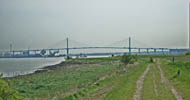
Long Reach - the foreshore by the location of the Hospital. The Queen Elizabeth bridge can be seen in the distance.
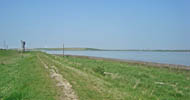
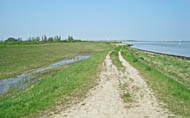
Looking up river at Long Reach.
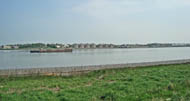
Looking across the river to the north bank.

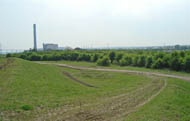
Looking inland at Long Reach. The chimney of Littlebrook power station can be seen in the background.
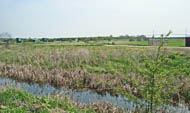

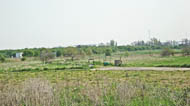
| Year | Cost | Number of patients admitted to Long Reach Hospital |
| 1954-1955 | £23,531 | 0 |
| 1955-1956 | £7,833 | 0 |
| 1956-1957 | £7,840 | 0 |
| 1957-1958 | £8,988 | 6 |
| 1958-1959 | £9,903 | 0 |
| 1959-1960 | £8,524 | 0 |
| 1960-1961 | £17,338 | 2 |
| 1961-1962 | £24,442 | 11 |
| 1962-1963 | £19,156 | 4 |
| 1963-1964 | £28,078 | 4 |
The last case of smallpox in England was in 1978, when Mrs Janet Parker, a medical photographer working in the Anatomy Department of the University of Birmingham Medical School, was infected by the virus which had travelled in air currents up along a service duct from the smallpox laboratory below. Mrs Parker was the last person to die of smallpox.
The last reported case in the world was Ali Maow Maalin, a cook at a hospital in Merca, Somalia, in 1977. He had the milder form and survived.
The World Health Organisation declared smallpox to be eradicated in 1979.
Burne J 1999 Smallpox afloat on Long Reach 1893. Bygone Kent 25, 275-282.
Currie M 2004 Fever Hospitals and Fever Nurses. A British Social History of Fever Nurses: A National Service. London, Routledge.
Payne F 2001 Joyce Green and the River Hospitals. Self-published.
Ricketts TF 1908 Diagnosis of Smallpox. London, Cassell.
http://hansard.millbanksystems.com (1965)
http://hansard.millbanksystems.com (1974)
http://hansard.millbanksystems.com (1979)
http://mcgovern.library.tmc.edu
www.aim25.ac.uk
www.dartfordhospitalhistories.org.uk
www.lrb.co.uk
www.newsshopper.co.uk
www.portcities.org.uk
www.templehilltrust.org.uk
www.workhouses.org.uk
Return to home page